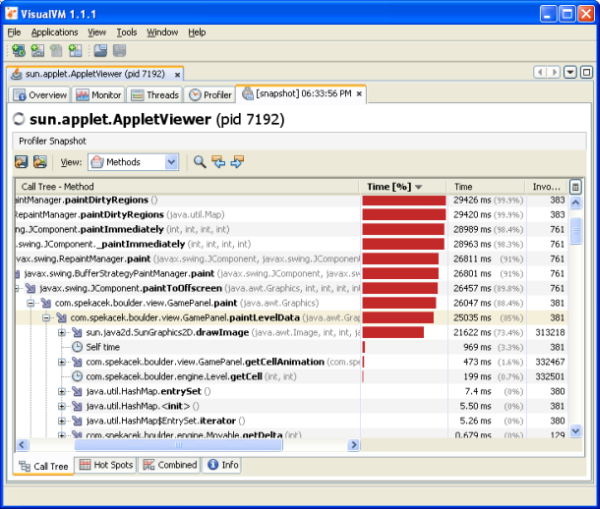



- #Yourkit java profiler vs visiual vm how to
- #Yourkit java profiler vs visiual vm install
- #Yourkit java profiler vs visiual vm update
That was taken care of by the IntelliJ plugin. I didn’t have to generate separate Tomcat startup. Using the plugin for my IDE, IntelliJ in my case, running JProfiler is even easier. This gave me a nice overview of where the request took the most time. I went for the CPU usage and could see the execution path. I could record memory usage and CPU usage. I attached the session to the listening process and it gave couple options. Then I run the server and it did wait till JProfiler connected to it. I had to select the application server home directory and the wizard generated a separate start up script for the application server to use with JPofiler. JProfiler was easy to set up and it walked me through a wizard where you can select the application server used to run the application. It can tell you which classes and methods are hit, but it will not show the flow through the application. It has default memory and CPU monitoring.
#Yourkit java profiler vs visiual vm update
VisualVM is a resource profile tool that comes with JDK starting from 6 update 7. The application is deployed on Tomcat server. My setup is a Spring based application with a RESTful interface using the MongoDB as its data store. The layout of application flow should include classes and methods against time In order to make the right choice, I set up some minimum requirements that the profiler should meet: There are many Java profilers out there that could help me to figure out this problem, only the question was which one should I use?
#Yourkit java profiler vs visiual vm how to
In order to figure this out in more detail, I decided to do some profiling to see where the application was using most of its resources and how to tackle this problem. I did wonder, maybe the performance could be increased by altering the application’s logic or maybe the application had reached its limit and needed to be scaled up. However, in my case the performance decreased at a rate much higher than when compared to the increased load. It seems logical to think when increasing the load on the application, that the performance will decrease. Please correct me if I’m getting the picture wrong, or neglecting somehow any other relevant aspect of OFI.While maintaining one of our client’s applications I noticed some performance problems under higher load. ISSPROF is great to find out what is happening now and may require being monitored in the future. OFI is great to monitor and control what you already know to need monitoring. I have used both of them before, and feel that they address different aspects of the monitoring spectrum. While OFI serves an operations management purpose (I need to know WHEN a known service is running slower than expected/required and be informed of such), along with great operations automation features (through Rules, Alerts, SLA, Actions). In my opinion ISSPROF serves an “immediate” operational purpose (I need to know right now WHY a service is running slow), and as a means to accurately check for service performance bottlenecks while still in development stages.
#Yourkit java profiler vs visiual vm install


 0 kommentar(er)
0 kommentar(er)
